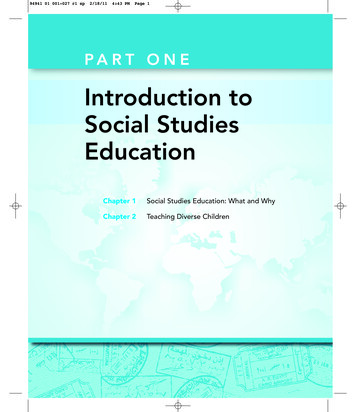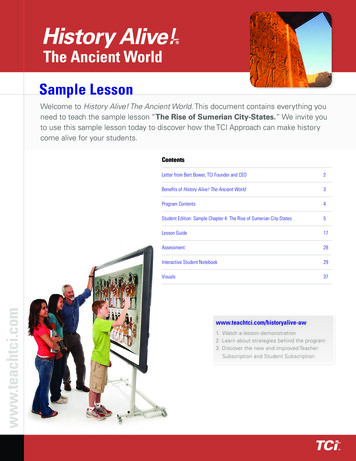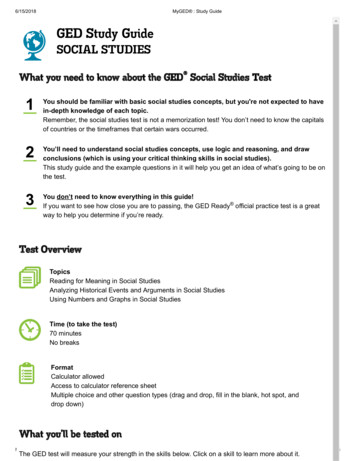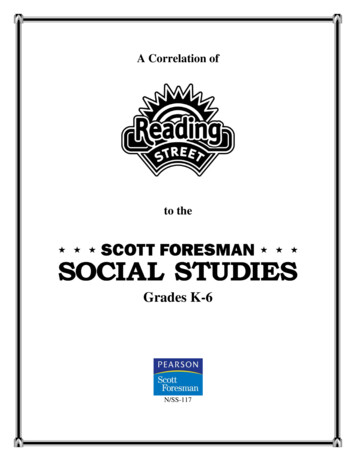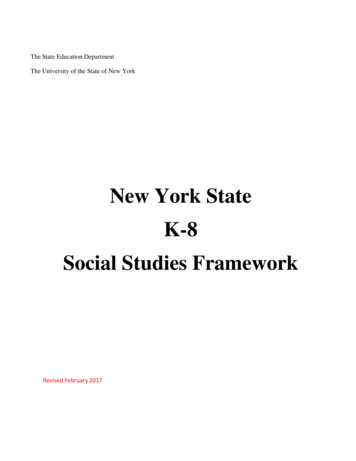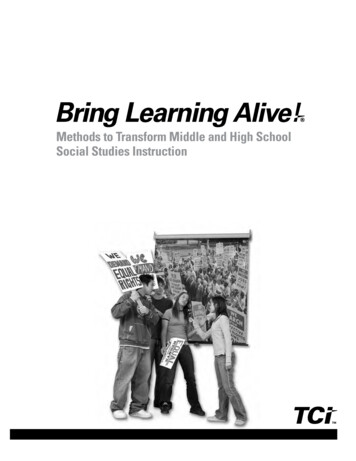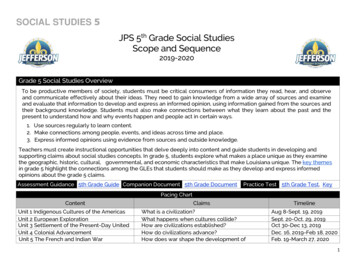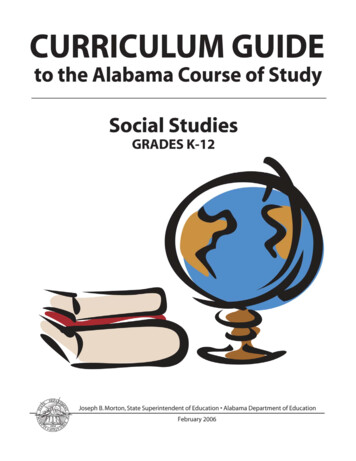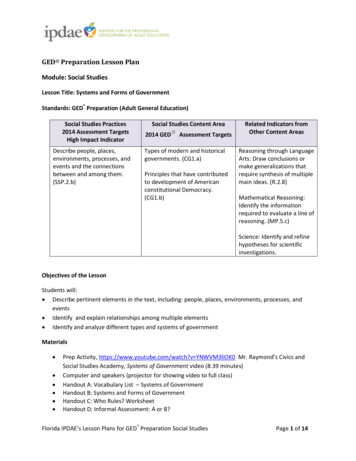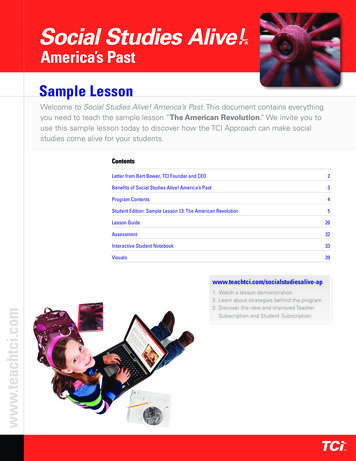
Transcription
Sample LessonWelcome to Social Studies Alive! America’s Past. This document contains everythingyou need to teach the sample lesson “The American Revolution.” We invite you touse this sample lesson today to discover how the TCI Approach can make socialstudies come alive for your students.ContentsLetter from Bert Bower, TCI Founder and CEO2Benefits of Social Studies Alive! America’s Past3Program Contents4Student Edition: Sample Lesson 13: The American Revolution5Lesson Guide20Assessment32Interactive Student m/socialstudiesalive-ap1. Watch a lesson demonstration2. Learn about strategies behind the program3. Discover the new and improved TeacherSubscription and Student Subscription
Welcome!Soc i a l Studi e s A l i ve ! A m e ri c a ’s Pa s tYou have in your hands a sample of Social Studies Alive! America’s Pastfrom TCI. This sample lesson is intended to give you the opportunityboth to review our program and to try it out in your own classroom soyou can join the growing body of elementary teachers who are turningto Social Studies Alive! to reinvigorate their social studies and languagearts programs.As a high school teacher who teaches only one subject, I am in awe ofelementary teachers. You not only teach all subjects—math, languagearts, science, and social studies—you juggle a myriad of other teachingand nonteaching responsibilities as well. That’s why we created SocialStudies Alive! America’s Past—to make it easier for you to integratelanguage arts skills and social studies skills, to create active lessons tokeep kids engaged, and to provide meaningful content to inspire younglearners to care about the world around them.I’m confident you and your students will enjoy this sample lesson. Ilook forward to welcoming you to the TCI community of inspired, activewelcomesocial studies teachers!2Best,Bert Bower, TCI Founder and CEO
Benefits of Social Studies Alive! America’s Past Cover state standards in history,geography, economics, and government. motivate student reading with the Reading Further feature in each lesson—ahigh-interest case study that drills downinto interesting events, concepts, andpeople discussed in the lesson.How can we help our students tounderstand their world? How do weprepare them to participate in it effectively?To these core social studies goals, TCIadds another: How do we get studentsexcited about this learning? Social StudiesAlive! America’s Past delivers on all threegoals. Interactive classroom experiences,coupled with fascinating reading, engageall learners in today’s diverse classroom.TCI recognizes the challenge to teachersof fitting social studies into a school daythat must concentrate so heavily on thethree R’s. To meet this challenge, TCI hascreated a social studies program thatserves double duty: reinforcing readingand language arts skills at the same timethat students learn social studies.benefitsSocial Studies Alive! America’s Pastwas created by teachers, for teachers.The program is flexible and easy to use,providing a variety of ways to meetstudent needs.3 support language arts instruction in thesocial studies curriculum with vocabularydevelopment, reading strategies, a varietyof writing activities, and numerousopportunities to develop speaking andlistening skills. Measure student mastery with rigorousassessments that cover comprehension,skills, and critical thinking. modify instruction for English languagelearners, learners with special educationneeds, and enrichment. extend learning with recommendedadditional reading opportunities and TCI’sonline Enrichment Resources, includinga Biography Bank and EnrichmentReadings.Social Studies Alive! America’s Past willhelp you ignite your students’ passion forlearning social studies and your passionfor teaching it!Soc i a l Studi e s A l i ve ! A m e ri c a ’s Pa s tTeachers can
Program Contents14 The Constitution2 American Indians and Their Land15 The Bill of Rights3 American Indian Cultural Regions16 Manifest Destiny and Settlingthe West4 How and Why Europeans Cameto the New World5 Routes of Exploration to theNew World6 Early English SettlementsSocial Studies Alive! America’s Pastcovers American history from thefirst migrations into the Americasthrough the 20th century. Intenseinteraction with the personalities,places, and events that structuredour nation leads students to be bothkeen observers of and informedparticipants in U.S. history.7 Comparing the Colonies17 The Diverse Peoples of the West18 The Causes of the Civil War19 The Civil War20 Industrialization and the ModernUnited States8 Facing Slavery9 Life in Colonial Williamsburg10 Tensions Grow Between theColonies and Great Britain11 To Declare Independence or Not12 The Declaration of Independence13 The American RevolutionSample Lesson:13 The American RevolutioncontentsF R E E 3 0 DAY T R I A L4Test-drive with a 30 Day TrialWith the Teacher Subscription, teachers can get anentire class interacting with one computer, an internetconnection and a projector. Students thrive on theimmediate feedback they get using the StudentSubscription’s Reading Challenges.www.teachtci.com/trialSoc i a l Studi e s A l i ve ! A m e ri c a ’s Pa s t1 Geography of the United States
Stude nt Edi ti on L e s s on G ui de A s s e s s m e nt I nte ra c ti ve Stude nt N oteb o o k V is u als6Yale University Art Gallery, Trumbull CollectionOn which side do you think thesemen are fighting? How can you tell?On which side do you think thesemen are fighting? How can you tell?
Stude nt Edi ti on L e s s on G ui de A s s e s s m e nt I nte ra c ti ve Stude nt N oteb o o k V is u alsThe AmericanRevolution13How did the colonists win the American Revolution?13.1 IntroductionIn Chapter 12, you learned how the American colonies declared theirindependence from Great Britain. From 1775 to 1783, colonists foughtin the American Revolution to win their freedom. A revolution is theoverthrow of one government and its replacement with another.The two sides in the war used different strategies, or overall plans,to try to win the war. At first, Great Britain seemed sure to succeed. Ithad a large navy. Its army was made up of skilled, full-time soldiers. TheContinental army of the colonies was small and untrained. The Britishwon most of the early battles.The colonial soldiers, or Continentals, had some advantages. They hadstronger reasons for wanting to win. They were defending their homesand their rights. Unlike the British, they were fighting on familiar lands.Also, foreign countries that were allies of the colonies sent aid to thestruggling Americans.Look at the visual metaphor below. The American Revolution can becompared to a tug-of-war between two unequal teams. The British armywas like the team on the right, strong and confident. The Continentalarmy was like the team on the left, small but motivated. As you read thischapter, think about how the smaller team might be able to win this tugof-war. How did the Patriots defeat the British?7American Revolution: Unequal Tug-of-WarContinental ArmyBritishArmyColonialAlliesThe American Revolution173
volunteer a personwho performs a servicefor freeenlist to agree toserve in an army or anavyWhen the war started, there was no American army. Instead,colonies had their own militias. These were made up of parttime soldiers, like those who fought the British soldiers atLexington and Concord.In 1775, the Second Continental Congress asked GeorgeWashington to lead a new army. This Continental army wasmade up of volunteers. Most of these men were poor farmers,merchants, and workers. At the start of the war, they enlisted inthe army for about one year at a time. Then they returned hometo take care of their families.Historians estimate that 8,000 to 24,000 men were inWashington’s army at any one time, including many AfricanAmericans. Women took part as well. They cooked for soldiers,mended uniforms, and cared for the sick and wounded. Somewomen even fought in battles.But the Continental army had a number of serious problems.Congress had little money to pay the soldiers or buy suppliesfor the army. As a result, the volunteers were poorly suppliedwith uniforms and guns. In addition, these men knew very littleabout being soldiers.Washington worked hard to train his men. He taught themto obey orders and to fight together. In speeches and writtenmessages, he encouraged them to believe that they could beatthe mighty British militaryforces.Like the Continental army,the colonial navy was small.It was made up of trade andfishing ships that carriedlittle cannons. With theirinexperienced army and tinynavy, the colonies were like aweak man about to fighta powerful giant.These Minutemen of Concordcould be ready to fight in aminute’s time. At the start ofthe American Revolution, theContinental army was made upof such untrained volunteers.The Granger Collection, New York174 Chapter 13 Stude nt Edi ti on L e s s on G ui de A s s e s s m e nt I nte ra c ti ve Stude nt N oteb o o k V is u als13.2 The Continental Army8
Stude nt Edi ti on L e s s on G ui de A s s e s s m e nt I nte ra c ti ve Stude nt N oteb o o k V is u alsThe Granger Collection, New York13.3 The British ArmyAt the start of the war, Great Britain was confident that it wouldsoon end the revolution. It had one of the strongest militaryforces in the world. The British navy’s 270 warships controlledthe seas. British shipyards built another 200 warships duringthe war.Great Britain’s army was large and well trained. Its soldierswere paid, and serving in the army was their full-time job. Mostsoldiers were experienced fighters. Their leaders disciplined themharshly. A soldier could be whipped for using bad language.Unlike the American Congress, the British Parliament hadmoney to buy food and weapons for its army. Each soldier wasgiven a uniform, a musket, a short sword, and a bayonet, orsharp blade. Soldiers attached the bayonets to the front ends oftheir muskets to use in close fighting.There were about 48,000 soldiers in the British army. Mostwere poor men who earned low pay. Some were from othercountries. Great Britain hired about 30,000 mercenaries fromGermany to fight in America.Thousands of American Indians joined the British as well.They sided with Great Britain because, since 1763, the Britishhad helped protect their lands from settlers. Thousands ofLoyalists also fought for Great Britain. New York’s manyLoyalists joined the British side at the start of the war.The British troops hadtraining and discipline. Theirgovernment gave them foodand weapons. They werewell supplied at the Battle ofBunker Hill, shown here.mercenary a soldierhired to fight for aforeign armyThe American Revolution1759
The Granger Collection, New YorkThe small Continental navywon a few sea battles.Captain John Paul Jonesdefeated the British warshipSerapis. During this clash,Jones said the famous words,“I have not yet begun tofight!”176Chapter 13The British army and navy were strong. But the British had amajor problem. They were far from home. Supplies, militaryorders, and soldiers had to travel 3,000 miles by sea across theAtlantic Ocean. The trip fromGreat Britain to America couldtake three months.Once British ships crossed theocean, it was often hard to get thecargo ashore. The Continentalshad few naval ships to attack theBritish warships. But they didcall on hundreds of privateers.Privateers were small, fastships with a few light cannons.Congress gave the captains of theprivateers permission to attackBritish supply ships. Ship captainscould keep most of the goods theycaptured. Later in the war, Frenchwarships also attacked Britishships.Unlike the British, Continentaltroops were fighting in their homecountry and could get suppliesmore easily. In addition, as thewar went on, the Continentalarmy found new ways of gettingweapons and supplies. Often, localcitizens sold or gave the armyfood. American troops capturedcannons and muskets from theBritish.American women also helpedthe Continental army. They ran the farms and businesses whilethe men were away fighting. Women brought supplies to thecamps, made uniforms, and worked as nurses. They also spiedamong the British.In contrast, the British had to fight in a country that wasnot their home. Most colonists refused to give them food orsupplies. The British often felt as though they were surroundedby people who disliked and even hated them. These feelingsmade the troops less eager to fight. Stude nt Edi ti on L e s s on G ui de A s s e s s m e nt I nte ra c ti ve Stude nt N oteb o o k V is u als13.4 The British Army Is Far from Home10
Stude nt Edi ti on L e s s on G ui de A s s e s s m e nt I nte ra c ti ve Stude nt N oteb o o k V is u als13.5 The Continental Army Is Motivated to WinContinental soldiers had a special advantage over the British—astronger motivation, or desire, to win.Continental soldiers believed that they were defending therights described in the Declaration of Independence. Theywere fighting to make a better future for themselves and theirfamilies. Many thought that these were goals worth dying for.Washington’s troops showed this strong motivation at ValleyForge, Pennsylvania, in the bitterly cold winter of 1777–1778.They were tired and starving. Many didn’t have warm clothingor even shoes. More than 2,500 men died that winter from coldand sickness. Yet the army didn’t give up.The British soldiers had less motivation. Most of them foughtbecause it was their job. They were not defending their homesor their freedoms. And Parliament had other problems besidesthe war. It had colonies to protect in places outside NorthAmerica. It had strong enemies like France and Spain. Andmany people in Great Britain didn’t want to pay for a war indistant North America.Of course, not all Americans wanted to fight the British.Loyalists still believed that independence was unwise. Inaddition, the British sometimes promised to free slaves whojoined their side. As a result, some African Americans foughtfor the British. As you have read, many American Indians alsofought for the British in hopes of protecting their lands.During the winter atValley Forge, the men inWashington’s army sufferedfrom starvation and bittercold. But they refused togive up.The American Revolution17711
On a winter night in 1775,Washington led his troopsacross the Delaware Riverto New Jersey. There, inthe Battle of Trenton, theydefeated German mercenariesto win a key early Patriotvictory.tactic a plannedaction, such as a way ofmoving or using troops,aimed at reaching acertain goal178Chapter 1313.6 Different War StrategiesThe British and the American armies used different warstrategies. Each tried to use its strengths. The British fought anoffensive war. They attacked the Continental army. Their aimwas to control key cities and the countryside. The Continentaltroops fought a defensive war. Their goal was to protect themselvesfrom attacks by the British army, rather than to destroy it.At first, the British tried to end the war quickly. They wonthe Battle of Bunker Hill near Boston in June 1775. They keptcontrol of Boston, the city they thought was the main Patriotstronghold. But they soon learned that men across the colonieswould fight for independence.In August 1776, the British took control of New York Cityafter the Battle of Long Island. Washington moved his meninto the countryside. From there, the Continental army usedtactics not common for that time. Patriot troops made surpriseattacks on small groups of British soldiers, and then retreated.Sharpshooters hid in the woods and shot British soldiers, one byone. These tactics puzzled British troops, who preferred to meettheir enemy face-to-face.So the British changed their strategy. They tried to use theirbetter-trained troops to openly engage Washington’s troops inbattle. But one night in December 1776, Washington sneakedhis troops across the Delaware River, from Pennsylvania toNew Jersey. There, in the Battle of Trenton, they surprised anddefeated German mercenaries who were celebrating Christmas.This was a key early Patriot victory. Stude nt Edi ti on L e s s on G ui de A s s e s s m e nt I nte ra c ti ve Stude nt N oteb o o k V is u alsWashington Crossing the Delaware by Emmanuel D. Leutze, (97.34) The Metropolitan Museum of Art, Gift of John Stewart Kennedy, 1897Photograph 1992 The Metropolitan Museum of Art12
Stude nt Edi ti on L e s s on G ui de A s s e s s m e nt I nte ra c ti ve Stude nt N oteb o o k V is u alsBy 1777, the British generals were determined to forceWashington’s army into the open. To do this, the British tookthe key city of Philadelphia.But Washington wanted to protect his soldiers. Rather thanrisk losing men in a direct battle, he let the British take the city.He then moved his men to Valley Forge to train and to avoidthe British for the winter. This location was easy to defend.It was also close enough to York, Pennsylvania, to protectCongress as it met there.13.7 The Continental Army Gains AlliesPatriot leaders needed allies to win the war. In 1776, Congresshad sent Benjamin Franklin to Paris, France, to seek help.France agreed to supply arms and to loan money toCongress. Some European soldiers also joined the Patriot cause.A 19-year-old Frenchman, the Marquis de Lafayette, became ageneral in the Continental army. Baron Friedrich von Steuben, aGerman soldier, played a key role in training colonial troops.In mid-1777, about 9,000 British troops crossed the borderfrom Canada. About 2,000 Vermont and New Hampshiresoldiers attacked them. Other Continental troops rushed tohelp. That October, with his army trapped at Saratoga, NewYork, British General John Burgoyne surrendered to AmericanGeneral Horatio Gates.The Battle of Saratoga was a turning point in the war.The colonists had defeated British troops. France now senttroops and ships to help thecolonists. Spain pledged tosupport France. Since Dutchmerchants were trading withthe Americans, Dutch banksloaned the Americans money.The Continental army nowhad strong allies.The British again tried anew strategy. For the nextthree years, they fought inthe Southern Colonies, whereLoyalists would help them.But the war did not go wellthere for Great Britain. In1781, Spain captured a Britishfort at Pensacola, Florida.turning point anevent that leads to adramatic change13At Saratoga, the Continentalarmy defeated British troops.The Battle of Saratoga, inOctober 1777, was a turningpoint of the war.The American Revolution179
13.8 The Treaty of Paris, 1783treaty a formalagreement between twoor more nationsAfter their defeat at Yorktown, the British were ready to endthe war. They were now fighting France and Spain, as well astheir former American colonies. Representatives from all thesecountries met in Paris to work out a peace treaty.Meanwhile, the fighting went on. The British navy shutdown American shipping on the seas. On land, the British stillcontrolled New York City; Charleston, South Carolina; andSavannah, Georgia. To the west, small but bloody battles werefought in Ohio, Kentucky, and western New York. Continentalsoldiers fought against British soldiers, Loyalists, and AmericanIndians. Villages burned. Women and children on both sideswere killed.Key Events of the American RevolutionH Americanvictoryn BritishvictoryME(part of MA)45 NConcord 1775NHNYMA65 WCT40 NRIPAMDH Long Island 1776H Trenton 1776Concord, MA177517761777177817791780178117821783Treaty ofParis endsthe war17831784NJATLANTICOCEANDEn Philadelphia 1777VA35 NNNCWE0GA30 NSSA5 SE 13.08a180 CyanChapter13YellowBlackMagentaSecond ProofTCI14 76075 W100H Yorktown 1781n Charleston 1780Sn Savannah 1778SC80 WH Saratoga 1777H Lexington and1775Second Continental1781Congress; WashingtonBattle ofnamed ContinentalYorktown, VAarmy leader1777-17781775Winter atBattles ofValley Forge, PALexington and200 miles200 kilometers70 W1776Battleof LongIsland, NY1776Battle ofTrenton, NJ1777Battle ofSaratoga, NY1777British capturePhiladelphia, PA1776Benjamin Franklinto Paris, France1780British captureCharleston, SC1778British captureSavannah, GA1785 Stude nt Edi ti on L e s s on G ui de A s s e s s m e nt I nte ra c ti ve Stude nt N oteb o o k V is u alsThen, that summer, a large British force marched to theVirginia coast. But the French navy stopped enemy ships frombringing the British support from New York. And Washington’sarmy and thousands of French soldiers arrived from the north.They trapped the British in the port of Yorktown. For more thantwo weeks, they pounded the British with cannon fire. Finally,British Lieutenant General Charles Cornwallis surrendered.The Battle of Yorktown was the last big battle of the war.With the help of their French allies, the Continentals had won akey victory.14
Stude nt Edi ti on L e s s on G ui de A s s e s s m e nt I nte ra c ti ve Stude nt N oteb o o k V is u alsIn September 1783, the war finally ended with the Treatyof Paris. In this set of agreements, Great Britain agreed torecognize the United States of America as an independentnation. Great Britain also gave the new country a huge amountof land. This included all the territory that was east of theMississippi River, south of Canada and the Great Lakes, andnorth of Florida. This area included land that the British hadpromised to American Indians. The British kept control of theirlands in Canada but returned Florida to Spain.In the treaty, the United States promised to restore the rightsand property of Loyalists. But many of the new nation’s citizensdid not keep this part of the agreement. This caused thousandsof Loyalists to flee to Great Britain, Canada, and other places.Many African Americans who had fought for the British alsoescaped to other countries.The Patriots had won the war. From this time forward, theformer colonists would be known simply as Americans.15SummaryIn this chapter, you learned how the colonists defeated theBritish to become a new country. You compared the warto a game of tug-of-war between two unequal teams. Theweaker side won because of some special advantages.The Continental army and navy were weaker than thoseof the British. But, unlike the British, the Continentalswere fighting at home. They had a stronger motivation towin. And they could fight a defensive war. In contrast, theBritish had to try to control large amounts of territory aswell as defeat the Continental army.When the Continentals won the Battle of Saratoga,powerful allies joined them. In the decisive Battleof Yorktown, French soldiers and ships helped theContinentals defeat the British. The Treaty of Parisrecognized American independence. It also gave a hugeamount of land to the United States.How did the widespread fighting affect Americanswho were not in the military forces? What happened togroups of people such as women, African Americans, andAmerican Indians? Read on to find out.The American Revolution181
13home front areasaway from the fighting ina country at warThe Revolution’s Home FrontThe American Revolution played out on manybattlefields. But soldiers were not the only ones to takepart. The war had many heroes. It also had many victims.Women gave much to the cause. Enslaved Africans andAmerican Indians were also involved. What was the war’simpact on these people?Rachel Wells lived in New Jersey at the time of the AmericanRevolution. She never took part in any battles. But she played arole in the war. And she suffered the dangers of wartime.Wells was a widow. But she was willing to do her part tosupport the war effort. She lent money to the governmentof New Jersey. Her funds helped supply the soldiers fightingthe British. As she later wrote, she “threw in all her mightwhich bought . . . clothing and let them have blankets.” Evenwith help like hers, however, the Patriots could not hold offthe British. At one point, British soldierscame through Wells’s town. Beforeleaving, they robbed Wells of a very largesum of money. She was forced to fleeto Philadelphia to try to rebuild her life.But by the war’s end, she was living inpoverty. She had to beg the ContinentalCongress to help her get her money back.“Pray forget not the poor weaklings,” shewrote in her plea.Wells’s story shows that the AmericanRevolution was about more than soldiersand guns. It affected people all over thecolonies. While many men marched off tobattle, life went on for the people they leftbehind. Life on the home front could becomplicated. And, as Wells found out, itcould sometimes be dangerous.While the men fought in the army, the womenwere left to defend their homes and care fortheir children. Stude nt Edi ti on L e s s on G ui de A s s e s s m e nt I nte ra c ti ve Stude nt N oteb o o k V is u alsReadingFurther16
Stude nt Edi ti on L e s s on G ui de A s s e s s m e nt I nte ra c ti ve Stude nt N oteb o o k V is u alsWomen and the WarAttacks such as the one Wells suffered were common duringthe war. Soldiers on both sides often raided towns. In additionto taking money, they stole food, clothing, firewood, and othersupplies. Many women saw their homes destroyed. “Familiesflying from the [houses],” wrote one Virginia woman describingan attack on her town. “Oh shocking! Oh horrible! Surely anyspot of earth on this globe, where freedom and peace can beenjoyed would now be more desirable than living here.”Women faced other hardships, too. Finding food wasa challenge. Supplies were short. Prices were high. Manyfamilies went hungry. And poor nutrition put people at risk fordisease. Many women and children died from illness.Still, the women carried on. They ran family businesses.They planted and harvested crops. They did their best to takecare of their children.Many women did even more.A few served as spies. Othersnursed the sick and wounded.A nurse had a greater chance ofdying from disease than a soldierhad of dying in battle.Some women used theirhousehold skills for the war. Forinstance, women in Philadelphialed an effort to raise money andmake clothing for the troops.Women helped win publicsupport for the war. Writer MercyOtis Warren, whom you readabout in Chapter 11, was oneexample. So was Mary KatherineGoddard of Maryland. GoddardThe Granger Collection, New Yorkhelped publish a newspaper.Some women traveled with the troops and cared for them.And in a few cases, they took part in combat. Anna Lanewas wounded at the Battle of Germantown in 1777. DeborahSampson dressed as a man and fought in several battles.Only when she was wounded did an army doctor discover hersecret. Mary Ludwig Hays McCauley, known as Molly Pitcher,took her husband’s place as a gunner when he was hurt at theBattle of Monmouth in 1778.17Women had many roles in thewar. Molly Pitcher took herwounded husband’s place asa gunner during one battle.
Stude nt Edi ti on L e s s on G ui de A s s e s s m e nt I nte ra c ti ve Stude nt N oteb o o k V is u als18This painting shows a blacksoldier (at left) protectinghis American commander byfiring at British soldiers.African Americans and the WarIn 1776, 500,000 slaves lived in the colonies. The war broughtthem challenges, choices, and opportunities.The British offered freedom to slaves who joined theirside. Tens of thousands of enslaved African Americans tookthis offer. They ran away from their owners. Many slaves gavevaluable service to the British. They fought in battle. Theyserved as spies. They performed many jobs in army camps.Many slaves did, in fact, win their freedom.But running away was risky. Sometimes, the British turnedaway slaves who wanted to join them. During the Battle ofYorktown, the British forced away many escaped slaves. Manyof them starved or died from disease. Others were caught andreturned to their owners.Some African Americans fought for the Patriot cause. Forexample, Salem Poor was a hero of the Battle of Bunker Hill.This battle was fought at Boston in 1775. Early in the war,African Americans could not join the Patriot ranks. Somewhite colonists did not want to arm slaves. This worry faded,however, as the war dragged on.
Stude nt Edi ti on L e s s on G ui de A s s e s s m e nt I nte ra c ti ve Stude nt N oteb o o k V is u alsAfrican Americans found ways to help the Patriots offthe battlefield, too. One example is James Armistead. Hepretended to serve the British. Instead, he spied on them. Forhis work, Armistead won his freedom.African American women also helped the Patriot cause.Phillis Wheatley was a slave. She was also a talented writer.She wrote a stirring poem that honored George Washington.Such efforts raised people’s spirits. This was vital during thelong, difficult struggle.American Indians and the WarAmerican Indians were another group affected by the AmericanRevolution. They saw both the colonists and the British as athreat. And both the colonists and the British sought to useAmerican Indians to their own advantage.Some tribes sided with the British. They thought thatthe British were less of a threat to their way of life than thecolonists were. A few tribes helped the colonists.Many American Indians, however, tried to stay out of thewar. In fact, they hoped that the two sides would weaken eachother. This, in turn, would help American Indians.Staying out of the war proved very hard. Few tribes, infact, could avoid being caught up in the fighting. Neither theBritish nor the Americans fully trusted the American Indians.They each punished them harshly for helping the other side.Both sides often raided American Indian villages and tookfood supplies. Hunger amongthe American Indians waswidespread.By the war’s end, manytribes were struggling tosurvive. The Patriot victory hadonly made things worse. TheBritish had previously tried toslow western settlement. Now,the British were gone. Soon,white settlers were againpushing west. They moved inlarge numbers onto AmericanIndian lands. The Pat
Social Studies Alive! America’s Past . from TCI. This sample lesson is intended to give you the opportunity both to review our program and to try it out in your own classroom so you can join the growing body of elementary teachers who are turning to . Social Studies Alive! to reinvigorate their

